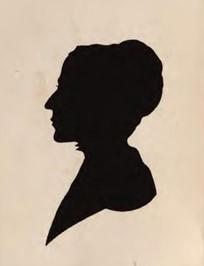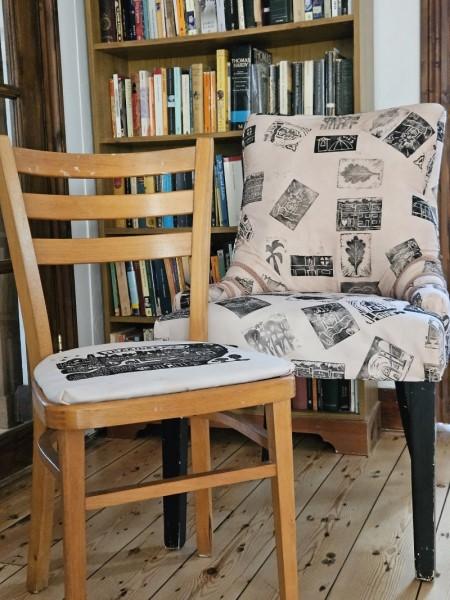The Meeting House
Hidden behind the unassuming shop frontage on the High Road and up a simple flight of stairs, 594 High Road holds centuries of remarkable stories of community activism, advocacy and philanthropic endeavor. It is a site that has welcomed people in Tottenham – whether refugees or locally-born - caring and campaigning for them, shaping the tradition of welcoming people to Haringey today.
This is the modern-day Meeting House for Tottenham Friends or Quakers. It was built in 1962 by Hubert M. Lidbetter (1885-1966), an architect who was a Quaker and became the most prolific 20th century designer of Quaker meeting houses.

(Quaker Meeting House, Tottenham High Road, c.1909. To the right of the image you can see an advertisement for Tottenham Palace. From the collections and © Bruce Castle Museum and Archive.)
Little has changed in the Quaker acts of worship and prayer since their founding in 1652. Defined by quiet reflection and modesty, in keeping with the simple, utilitarian style of Meeting Houses, Friends worship in silence, usually lasting for one hour. Perhaps one or more Friends contribute spoken ministry and the Meeting closes with the shaking of hands.
There has been a Friends Meeting House on this site in Tottenham for centuries. Before establishing a permanent place to meet, local Quakers came together to worship in people’s homes. In 1698 they met in the home of a Friend, Francis Clare, and also hired a house at Tottenham High Cross. The first mention of Quakers in Tottenham was in 1689. It was not until that year that the Quakers felt able to establish roots in a community, following the introduction of the Toleration Act. Until then Quakers had suffered severe persecution for being dissenters from the main Church of England.
The original Meeting House was built in 1714 and enlarged in 1777. It was built to be functional and simple with little evidence of design. By 1833 the Meeting House was practically rebuilt on its old foundations.
The Unknown Burial Ground
With a growing community, the late 18th century Tottenham Meeting also needed a burial ground. In 1803 land to the rear of the building that was once part of an orchard and owned by a member of the Meeting - Thomas Shillitoe (who had the house next-door) - was transferred for use as a burial ground. Gravestones were at first disallowed but by 1816 low oval-topped stones were erected. Stones were engraved simply with the name and dates of death and birth. A plan was kept of the spot where each Friend was buried.

(Plans for establishment of Friends Burial Ground also showing orchard, 1803. Image courtesy Edmonton Hundred Historical Society publication, 1978)
Quakers in Tottenham
The late 18th and early 19th century saw the Tottenham Meeting attended by a considerable number of wealthy Friends. They had financial independence with time and energy to give to their philanthropic and campaigning activities. Although now free from persecution themselves, these Quakers were not allowed to enter politics and so they directed their skills in business, science and education. The work of these local prominent Quakers became of national and international significance. They could advocate for causes close to them, including equality of education and the abolition of slavery.
Many Tottenham Quakers learnt skills such as nursing and teaching, others dedicating their time entirely to philanthropy. An enthusiasm for travel and the constant learning and sharing of new ideas, which would be brought back to Tottenham in Friends’ Meetings, defined the lives of many local Quakers. Notable Tottenham Quakers include Priscilla Wakefield (1751-1832), William Forster (1818 – 1886), Luke Howard (1772 – 1864), Hannah Kilham (1774 -1832), William Dilwyn (1743- 1824) (who came to England to begin a campaign against slavery) and Joseph Lancaster (who didn’t frequent the Meeting House at 594 but would have known its attendees very well). For more information on Tottenham’s Quaker heritage, visit the Tottenham Quakers’ website.

(Hannah Kilham – silhouette portrait)
These individuals helped establish a legacy for later Tottenham Quakers, including their belief in pacifism – their opposition to war and violence.
During the First World War when men were made to join up and fight once conscription was made law in 1916, many Quakers identified themselves as conscientious objectors (known as COs). Amongst these was Fred Murfin (1888 – 1971), a printer originally from Lincolnshire, who lived at 47 Summerhill Road N15 and was associated with the Tottenham Meeting as well as the No Conscription Fellowship in London. It was said that Quakers were to be exempt from military service but Fred did not want special treatment. A tribunal at Tottenham Town Hall sent Fred to battle in France with other objectors. They refused to fight and were court-martialled; their sentence was death by firing squad. By chance the British Minister of War was in France and, hearing of their fate, intervened. Their sentences were commuted to ten years’ imprisonment. All First World War COs in Haringey, including Quakers, are remembered and their lives documented online by the Haringey First World War Peace Forum.
Further resources
Find out more about others from Haringey involved in campaigning for peace over the 20th and 21st centuries.
Think Pink - Mulberry Trees and Tottenham Cake
Although Tottenham High Road is largely urbanised, there are surviving pockets of natural beauty, reminding us that Tottenham was once in the midst of the countryside!
One such hidden natural gem is the Mulberry Tree in the grounds of the Quaker Meeting House at 594 High Road (first established in 1715), now looked after as part of the Mulberry Tree Community Garden. This tree was once part of a much larger orchard behind the Friend’s Meeting House. Its fruit is said to have given Tottenham Cake’s bright pink icing its distinctive colour.

(Inspired by the Quakers’ mulberry tree and Tottenham Cake, Sunbul Akhtar used natural dyes to tint her fabric pink for her Haringey Feast Storytelling Chair).
Tottenham Cake is an iconic local (very) sweet treat. It was first baked by local Quaker and baker, Henry Chalkley, almost 125 years ago. Tottenham Cake was sold for 1d a cube at Spurs’ first FA Cup win in 1901 – and since then has gained wide popularity with local children over the generations. It is fondly remembered in the childhood memories of the playwright Ted Willis (1914 – 1992) - later becoming Lord Willis - who grew up in Stanley Road in West Green.
Here’s local historian Chris Protz recalling the old Mulberry trees on nearby Reform Row N17:
“Our mothers would let us know when the mulberries were ripe for picking […] we could wander round collecting the rich purple fruit. Plenty went into our bowls, but quite a lot into our mouths.”
See a little more about Tottenham Cake recipes, including one by Peter Brown and his wife Doreen of the Tottenham Meeting, who would have used the mulberries from the Tottenham Meeting’s grounds.
Further resources
African Women’s Welfare Group (AWWG)
This now occupies part of the site at 594 High Road along with the now much smaller Friend’s Meeting House. Established in 1989, this Pan-African Women’s grass roots organisation advocates for the rights and dignity of newly arrived African women, refugees and asylum seekers in the UK. AWWG aims at empowering African refugees, migrant women and children in order to fulfil their potentials.
Further resources
Location
Friends and Advocates
594 High Road
Tottenham
N17 9TA
United Kingdom